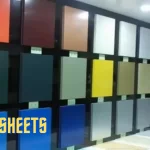Knowledge is the key that opens the door to the right choices. This is especially true when it comes to purchases where the benefits are expected to last for decades! Aluminium Composite Panels (ACPs) are definitely in this category where informed decisions must be based on sound, holistic knowledge. With the rampant acceptance of ACPs in the construction, architecture, and interior décor worlds, it is important to understand this product, so that when you put down your money, it will prove to be an investment and not a sunken cost. This blog will present guidelines to help achieve this goal, by ensuring your ACP choice meets all required standards, to serve your long-term interests.
Post your Requirement
Guidelines for Choosing the Right ACP
I] Safety and Qualitative Considerations
-
Core Material and Fire Safety
The fire safety aspect of ACPs is largely determined by the Core Material that is sandwiched between two high-quality Aluminium sheets. There are various degrees of insulated cores, some of which are: PE Core made of 100% Polyethylene (PE) which is flammable; FR Core made of fire-retardant composite material containing non-combustible material like ATH and MDH compounds, Fire retardant FR Class A2 which has 90% Mineral Core, FR Class B (Eurobond FR Plus) with 70% mineral core, and Aluminium Core made of Aluminium Honeycomb Structure or Solid Aluminium. The core material additionally influences insulation, soundproofing, and environmental impact. The choice of ACP is determined by the level of safety that is demanded by the project.
-
Coating and Paint
ACPs are coated or painted using different materials keeping in mind UV stability, weather resistance, and durability. The more commonly used ones are PVDF resin, (XT/ High Durable) polyester paint for PE Interior Panel sheets; Nano PVDF for Panel sheets; and FEVE resin or high-density polyester coating for Digital Printing/ Signage Panel sheets. PVDF coatings are more expensive than PE coatings but are also more robust and long-lasting. Coatings come in a wide choice of colours, textures, and designs. You can choose from finishes like gloss, matte, metallic, wood, stone, marble, sand, mirror, solid series, etc. Good quality ACP sheets are painted using the double bake process which ensures that the paint doesn’t peel off easily and the surface is scratch and dent-free. The choice of ACP coating will be influenced by economic, aesthetic, and durability preferences.
-
Thickness and Size
Generally speaking, the thickness of an ACP defines its sturdiness, weight, formability, and price. The high thickness of the Aluminium Layer gives it the strength for exterior applications, as well as the panel thickness, adding to the weight makes it stronger. However, Eurobond’s innovation has gifted the construction industry with exceptions like EUROCORE – an Aluminium Core Composite Panel, and EUROCOMB – an Aluminium Honeycomb Panel which is lightweight and yet very durable. The standard size of the panel dimensions is 1220mm x 2440mm, 1220mm x 3050mm, and 1220mm x 3660mm & can be customized as per the client’s requirements. Available in 3mm to 25mm thickness.
-
ACP Certifications
ACP manufacturers are mandated to comply with various Government certifications to ensure that the required quality and safety specifications are met vis-à-vis the manufacturing process and the final product. It is therefore important to choose manufacturers that have valid certifications in place. Some of the relevant certifications for ACPs are ISO, and FR Certifications.
ISO certification indicates that the ACP meets all industry standards of quality and price. FR certifications are issued for tests like EN-13501, and ASTM E119, indicating various degrees of fire retardation as defined by national and international fire safety standards. The Euroclass System for Fire Safety Classification which is mandatory in EU countries, introduced the EN13501 standard to classify building material’s fire behaviour and the contribution of the material in a fire. These products are rated A1 – F, depending upon the contribution to the fire load, with Classes A1 and A2 being the best (as non-combustible) Class B being limited combustible, and further classifications of C – F (combustible).
-
ACP Manufacturer’s Reputation:
Another checkbox that needs to be ticked when buying ACPs is the market reputation of the manufacturer. Market buzz can confirm, or discredit the manufacturer’s claims on quality, delivery schedules, customer service, installation assistance, etc. All these are important criteria as one can benefit from the experience of other purchasers – experience being the best teacher. The company’s website is one source for checking these details, but to eliminate self-bias, the internet and local, reliable trusted shops can be a great source for getting this information.
-
Test the Overall ACP Quality
It is important to test the overall ACP product quality as it is meant to last for decades. Check that the ACP manufacturing process and final product are in line with industry standards w.r.t. non-negotiable qualities like flawless flatness, water resistance, UV resistance, all-weather resistance, scratch resistance, etc. Here are some of the simple tests to check the quality of ACP.
It’s crucial to thoroughly examine the specifications, test reports, and certificates of both the product and the company before making any purchasing decisions. By doing so, you can ensure that you are well informed about the quality, performance, and safety of the product you are considering.
To check the sturdiness of the ACP sheet, try to bend its corner. If it does not bend or break easily it is indicative of good quality in terms of aluminium, core material, and adhesive. If a sample is available, its strength can be determined by striking it against a hard surface to check if it is brittle.
Candle test: Remove the aluminum sheet from the core and ignite the ACP center. Keep the core in the flame for around 1 minute. The test confirms the core’s non-flammability due to minerals ATH and MDH. The ACP panel is fire-resistant, releasing only non-toxic water vapor when burned.
Another popular method is Salt spray testing. It checks the corrosion resistance of coatings and materials, like fasteners. It simulates accelerated corrosive attack to predict the coating’s protective capability against metal corrosion.
II] Service-Related Considerations
- Installation Technique:
An important service-related consideration is the installation technique recommended, and whether the manufacturer provides assistance if it is required. ACP installation needs to be correctly and safely done to ensure that the cladding is robust and to avoid damage. There are two types of installation viz. Dry, and Wet installations. Dry installation involves mechanical fastening of the ACP to the substrate, and Wet installation uses adhesives to secure the ACP to the substrate.
Warranty
It’s important to check on the warranty period that the ACP manufacturer offers, as it speaks volumes of the trust the company has in its products. Considering that ACPs are supposed to be robust, all-weather resistant, and meant to last for decades, it is important that the warranty reflects confidence in these features. Check the fine print to ensure that the warranty does not have adverse terms and conditions.
Customer Service
The after-sale support that the manufacturer provides is also an important consideration. Hence it is important to check if technical support is extended during the ACP’s life expectancy. A company that has a good customer service orientation generates more confidence and increases the customer’s comfort level. Ensure that the customer service policy is not just on paper but translates into reality.
III] Narrow Down on ACPs that Best Suit Your Needs
Having checked on all the technical, qualitative, safety, warranty, and customer service aspects, you are now better equipped to make the right decision and narrow down your options to trustworthy manufacturers. All that’s left to do is to choose the type of ACP that best suits your needs in terms of fire safety, sturdiness, weight, weather resistance, etc. The ACP choice may differ for exteriors and interiors. There will also be aesthetic considerations like colour, texture, and design that will influence choice. The cost will also be a factor, but safety must supersede cost in decision-making. It’s equally important to choose an ACP which is environment-friendly and fully recyclable, to do your bit for the environment.
Coming to the Investment – Cost Debate:
Opting for a trusted ACP brand like Eurobond, cuts expenses on multiple counts and thus proves to be an investment rather than a cost. First and foremost, Eurobond ACPs last for decades avoiding the costs of frequent future replacements. Our confidence in our products’ durability is reflected in our warranty, which ranges from 10 to 20 years, depending on the selected product. Secondly, our ACP cladding regulates the heat that reaches the building structure, and provides an air gap for ventilation, thus contributing to reduced energy bills for air-conditioning. Thirdly the low cost of maintenance makes Eurobond ACPs an overall cost-effective option. Fourthly Eurobond ACPs are fully recyclable and eliminate the cost of heavy disposal expenses. Thus, when you opt for a brand like Eurobond which is quality, safety, and environment conscious, your ACP becomes a true investment throughout its life cycle – eliminating frequent replacement costs, and reducing recurring expenses of energy and maintenance bills far into the future.
Transform your buildings into works of art with Eurobond ACP – the perfect fusion of durability, style, and sustainability.























Post A Comment